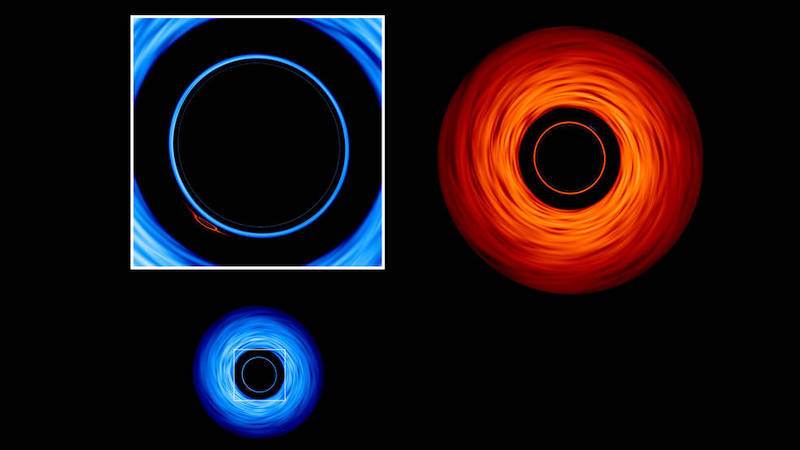Black holes are one of the most fascinating and mind-bending phenomena in the universe. The gravity of a black hole is so powerful that not even light can escape it. There are many varieties of black holes, and, in April 2021, NASA released a new visualization of binary (double) black holes, two black holes orbiting a common center of gravity, circling each other in a cosmic dance. The black holes depicted in this visualization are millions of times more massive than our sun. Each is surrounded by a disk of hot gas called an accretion disk. In the visualization, the gravity of the black holes distorts the light coming from their respective disks, producing a mesmerizing light show. Various other relativistic phenomena also contribute to the display.
How does this happen?
When you view the disks almost edge-on, from the orbital plane, they have a double-bulged look to them, reminiscent of seeing Saturn from the edge, slightly above or below the ring plane; a flat circular disk with a huge round bulge on top and bottom.


When one of the black holes passes in front of the other, however, as seen from our vantage point, the intense gravity of the black hole closer to us distorts the light coming from the black hole behind it. This creates a rapidly changing series of colorful arcs as they move. The light from both black holes is being modified by the distorted fabric of space-time near the black holes.
The creator of the visualization, Jeremy Schnittman, an astrophysicist at NASA’s Goddard Space Flight Center, stated that:
We’re seeing two supermassive black holes, a larger one with 200 million solar masses and a smaller companion weighing half as much. These are the kinds of black hole binary systems where we think both members could maintain accretion disks lasting millions of years.
In the visualization, the light from the disks is shown as brilliant blue or red. This is partly to make them easier to distinguish, but also depicts the different temperatures of each disk. Hotter gas is shown as blue and cooler gas as red. Most of the light in both disks is emitted in the ultraviolet (UV) part of the electromagnetic spectrum instead of in visible light.
Stronger gravitational effects also produce higher temperatures so the disks look brighter on one side (the side closest to their respective holes). This is due to gravity distorting the light coming from different parts of the disks. The Doppler boosting effect – also known as relativistic beaming – also plays a part in these changes in brightness: the luminosity of the disk is affected by the gas moving faster near the black hole so that the side that is rotating toward the viewer appears brighter, while the side rotating away looks dimmer.

Another phenomenon that contributes to this visualization is relativistic aberration, where the black holes look smaller when they are moving closer to the viewer, but larger when moving away. That sounds counter-intuitive, but nature can be weird.
What happens if you look at the black holes from above, instead of from the side?
Those odd visual effects go away, but bizarre new ones take their place. Each black hole produces a small visual “copy” of the other black hole that orbits around it, sort of like watching a planet orbit a star from directly above. But those small copied images show the partner black hole in an edge-on view (the way we saw them before, from the side) instead of an above view. How does that happen? The light from the black hole disks is being bent by gravity at 90 degrees. This means that we can see both the primary black hole disk face-on from above, and the smaller image of the companion black hole disk edge-on, at the same time. How bizarre is that? Schnittman said:
A striking aspect of this new visualization is the self-similar nature of the images produced by gravitational lensing. Zooming into each black hole reveals multiple, increasingly distorted images of its partner.
The researchers used the Discover supercomputer at the NASA Center for Climate Simulation to create the visualization. It would have taken about a decade to make using just a regular desktop computer, but with Discover, while using only 2 percent of its 129,000 core processors, it took only a day.
The result is the beautiful movie of two black holes in their cosmic dance that you see here.

In April 2019, astronomers were able to take the first direct image of a black hole. The bright ring is formed as light is bent by the black hole’s immense gravity. This black hole is located in the center of the galaxy M87, 55 million light-years from Earth, and is 6.5 billion times more massive than our sun. An updated photo of the same black hole, showing its magnetic field, was released just a few weeks ago.
Bottom line: NASA has released a cool new visualization showing two massive black holes orbiting each other in a stunning display of light from their accretion disks.











